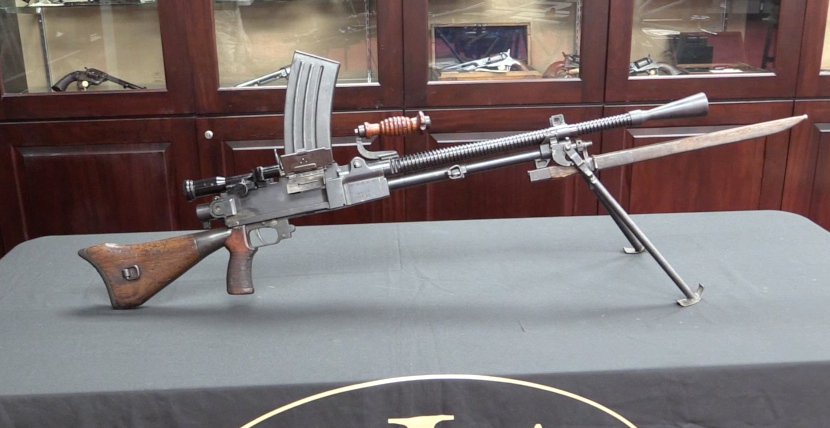Before standardizing on the Type 2 paratroop rifle (a 7.7mm Arisaka that broke in half at the chamber), the Japanese military tested a variant of the Type 38 carbine with a folding stock retrofitted into place. Very few of these were made, and Rock Island is selling two of them at their upcoming September Premier auction. Both are mechanically functional and have intact chrysanthemums, but one has about 40% of its finish remaining while the other has more finish and is in better overall condition.
Related Articles

Bolt Action Rifles
Type 46 Siamese Mauser
Siam, now known as Thailand, was one of the few independent south Asian nations around the turn of the 20th century. Looking to modernize its military to protect against colonial imposition, is decided in 1903 […]

Semiauto pistol
Early Pistol Cartridges – What, When & Why?
In a recent discussion with a friend the topic of early automatic pistol cartridges came up. Specifically, looking at the context of which cartridges were actually available at which times, and how this might provide […]

Light MGs
RIA: Nambu Type 96 & Type 99 LMGs
The Type 96 and Type 99 Nambu light machine guns were arguably the best LMGs used by any nation during WWII – they were light, handy, accurate, durable, and reliable. Designed by Kijiro Nambu to […]

Very nice! It’s always fascinating to see Japanese arms and rifles – especially prototypes!
Similar folding stock was used in Hungarian Danuvia 39.M paratrooper variant sub-machine gun.
http://www.hungariae.com/Danu39.htm
The Japanese type 100 8mm SMG used essentially the same setup;
http://www.wwiiguns.com/store/images/type100_paratrooper_store_1_1111_9fc.jpg
It was also made in a fixed-stock version, as with the Type 38 carbine.
Incidentally, the Japanese “Special Landing Forces” (naval infantry) in the Philippines in 1941/42 also had SMGs, but they were mostly Bergmann MP.18 I models in 7.63 Mauser, bought from SIG in Switzerland.
Today of course many rifles and SMGs have folding stocks built on this principle, albeit with much better engineering. One peculiarity of such stocks is that like the Type 1, they generally fold to the right, which on most modern weapons blocks access to the trigger guard and magazine catch. This is especially true of AK-based designs like the Galil, on which it also blocks the safety/selector/dust cover. Granted, the Galil has the Uzi-type thumb selector on the left grip, but it’s still a bit of a bother.
cheers
eon
Is the hinge screwed to the receiver like a trigger guard or just into the stock?
The dust covers rattling and being thrown away because of said rattling by the Japanese troops is a myth that just won’t go away, much like the Garand ping myth. If people knew how harsh the Japanese military was, they would never believe a lowly soldier would ever throw away a part of his rifle. The Emperor’s chrysanthemum is on that receiver for a reason. It’s HIS rifle. You don’t do something like that to the Emperor’s rifle and expect to not get beaten by your NCO and/or officers.
They don’t really rattle unless you make them rattle. They were all hand fitted to the receiver by the factory so they wouldn’t rattle and rub the finish off of the gun. And the field armorer’s kit had spare unnumbered dustcovers. The only time they rattle is when the action is cycled, which means you discharged the gun. I can assure you that the rifle firing is MUCH louder than a small rattle.
Every single picture of these rifles before and early on in the war has the dust cover on every rifle shown. Late in the war, that changes. They stopped putting them on new Type 99 rifles mid-way through the war, but even early and pre-war Type 38 and Type 99 rifles shown up without dust covers, monopods and all those bits late in the war. My guess is that the Japanese started scrapping them from rifles warehoused in Japan late in the war. There are plenty of unissued early Type 99 that still have all of it’s screws still factory staked, but missing those parts just how it was pulled out of a warehouse by some GI post-war.
But what about the Type 99s that still have their monopod and AA sights, but no dust cover? I think that was from the GI that took the bolt out not knowing how to put the dust cover back on. They’re little tricky the first time you try to put one back on. On the way back home it was supposedly common for the soldiers to be ordered to remove the bolts from their trophy guns and all the bolts were collected and when they got to port they were all handed a bolt. No doubt there is a big pile of dust covers on the bottom of San Fransisco bay. That would also explain why so many guns have mis-matched bolts.
“I can assure you that the rifle firing is MUCH louder than a small rattle.”
Not to mention than on battlefield are much more other louder weapons like machine gun, mortar, field artillery, ground-support aviation.
I would guess that later in the war, the Japanese military started removing the dust covers and melting them down due to shortages of steel.
I still subscribe to view that GI’s ditched the majority of dust covers. They really don’t rattle enough to attract attention during a battle. If the Japanese brought them in to melt them down, I would think they would have started with older models and school rifles.
Back to the Type1 paratroop rifles; I wish there was a mention in the video that there are quite a few fakes floating around out there. They are easy to spot once you know what to look for but one problem is that the hinge on these rifles vary quit a bit from rifle to rifle.
Side note, I have one of the T100 smg stocks. The hinge is broken though, and I can see why they decided to give up on the idea due to that reason alone.
I can understand GIs throwing away the dust covers because they couldn’t figure how to put them back on, but that doesn’t explain all the early Type 99s that are missing their monopods and AA sight wings. No reason for the GIs to remove them. Both of my Type 99 long rifles (not the more common and later short rifles) are missing their monopods and dust covers, but all the screws are still factory staked.
When the Japanese decided to stop putting AA wings and monopods on rifles, there was a period of production where the rear sights and barrel bands were left unchanged but the wings and monopods were simply left off – you can look up the different arsenals and series numbers to determine whether a rifles should have either of those parts. Later on, the other parts were modified to remove the attachment points for the unused bits.
I just bought one, prices are jumping fast. There are fakes out there, be careful